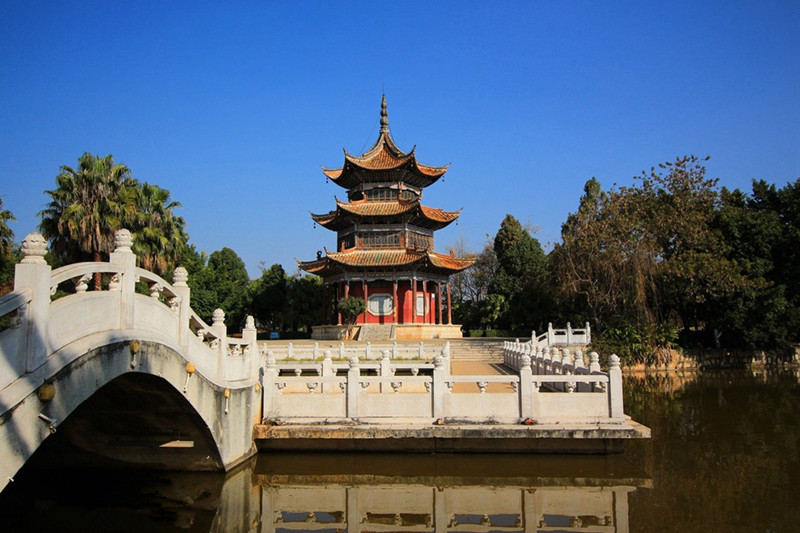Yingzhou Pavillion of Nanhu Lake in Mengzi City, Honghe
Overview
Yingzhou Pavilion (瀛洲亭) stands majestically, showcasing its impressive architecture. Located on the central island of Nanhu Lake (南湖) in Mengzi City (蒙自市), it features exquisite white marble carvings and serves as a revolutionary martyrs’ memorial on Song Island (菘岛) to honor the fallen heroes. The pavilion is not only a historical site but also a place where scholars gather, offering a glimpse into the serene beauty of the area, which is often compared to the mythical Penglai (蓬莱) paradise.
Historical Background
Yingzhou Pavilion is regarded as one of the finest garden architectural works from the Qing Dynasty (清代) and is included in the “Complete Works of Chinese Art: Garden Architecture Volume” (中国美术全集——园林建筑卷). Initially built during the Qing Dynasty, the pavilion was destroyed during wartime and underwent several renovations to reach its current scale. The pavilion features a wooden hexagonal structure with three tiers of eaves, topped with glazed tiles. Its beautifully painted beams and golden embellishments create a brilliant spectacle, enhanced by the sound of wind chimes hanging from the eaves.
The pavilion is situated near the small Nanhu Lake, which historically was known as Caohai (草湖), a natural dam pond in the Mengzi area. In the 31st year of the Jiajing era (明嘉靖三十一年), the governor of Lin’an (临安), Zhang Shiyuan (章士元), dispatched a secretary, Zhou Song (周崧), to lead the local people in constructing channels to divert water from nearby springs into the lake. This led to the formation of the ancient scenic feature known as “Four Waters Surrounding Xiang” (四水萦祥).
During a severe drought in the 1st year of the Longqing era (明隆庆元年), Governor Qian Bangcheng (钱邦称) and his assistant Hu Wenxian (胡文显) organized a project to dredge Nanhu Lake. They used the silt from the lake to construct three hills named “Penglai, Yingzhou, and Fangzhang” (蓬莱、瀛洲、方丈), which became known as “Three Hills Nurturing Elegance” (三山毓秀).
In the 29th year of the Kangxi era (清康熙二十九年), Wang Laigui (王来贵), acting as the governor of Amei Prefecture (阿弥州), oversaw the dredging of the Fa Guo Spring (法果泉) and the construction of a northern embankment. The local people, grateful for his efforts, built a three-tiered pavilion on the east side of the lake named “Yingxian Pavilion” (瀛仙亭).
In the 14th year of the Guangxu era (清光绪十四年), Yingxian Pavilion was destroyed during the Xianfeng conflict, leading to its reconstruction and renaming as “Yingzhou Pavilion” in the 1st year of the Xuantong era (清宣统元年). Subsequently, officials built an embankment in the lake, dividing Nanhu into large and small lakes, with Yingzhou Pavilion located on the smaller lake.
Architectural Features
Yingzhou Pavilion is a three-tiered hexagonal pavilion with a pointed roof and a unique eave structure. The first level features a circular corridor supported by thirty pillars. The intricate design includes a wooden staircase leading to the third level, which has a coffered ceiling. The base of the pavilion is made of stone, with six stone carvings on either side of the steps, depicting auspicious patterns such as “Phoenix Penetrating Peony” (凤穿牡丹), “Five Blessings Bestowing Longevity” (五福捧寿), and “Deer Holding Lingzhi” (鹿噙灵芝).
Yingzhou Pavilion is historically significant, showcasing exquisite craftsmanship and a beautiful environment. It represents a pinnacle of ancient Yunnan architecture and garden landscape design, holding substantial cultural and historical value.
Location
Address: Xiaonan Lake, Mengzi City, Honghe (云南省蒙自市小南湖)
How to Get There
- By Public Transport: Regular bus services from Mengzi City center to Nanhu Lake are available, taking approximately 30 minutes.
- By Car: The pavilion is accessible by car, with parking available nearby.
Travel Tips
- Best Visiting Time: Spring and autumn are ideal for visiting, providing comfortable weather and beautiful scenery.
- Photography: Capture the beauty of the pavilion and the surrounding lake, especially during sunrise or sunset.
- Local Culture: Attend any local events or ceremonies held at the pavilion to experience the cultural richness of the area.
- Nearby Attractions: Explore nearby sites such as the Southwest Associated University Mengzi Branch Memorial Hall (西南联大蒙自分校纪念馆) and the former customs office (蒙自海关旧址) to learn more about the local history.
- Respect the Site: Ensure to keep the area clean and respect the historical significance of the pavilion and its surroundings.

















